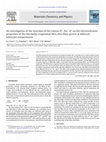Papers by Dr. Keyur Patel

Synthesis and Reactivity in Inorganic Metal-organic and Nano-metal Chemistry, 2007
Nanocrystalline zinc oxide-thin films have drawn the attention of researchers due to its attracti... more Nanocrystalline zinc oxide-thin films have drawn the attention of researchers due to its attractive properties like transparency in visible region, abundance in nature and gas sensitivity. Nanostructured Zinc oxide (ZnO) thin films were grown on silicon, alumina and glass substrates at various substrate temperatures using a 6 kW electron beam evaporation technique. The effects of film thickness, growth temperature and substrate on the crystallinity of deposited ZnO films were investigated using X-ray diffraction, scanning electron microscopy, optical absorption and photoluminescence studies. Our studies show that good quality films are obtained for silicon substrate for a growth temperature of 2508 8 8 8 8C. Film thickness plays an important role on the evolution of the nanostructures. SEM studies combined with XRD analysis reveal that ultrathin nanorods are grown with (002), (101) and (102) orientations. All the ZnO films show room temperature photoluminescence emission bands at 394 nm and 468 nm. Optical absorption studies show strong absorption at 377 nm. Details of the structure and optical properties correlation will be presented and potential of a simple technique such as e-beam deposition to grown ZnO nanostructures suitable for optoelectronic application will be assessed.
Journal of Materials Science-materials in Electronics, 2011
Indium tin oxide (ITO) thin films were deposited by radio frequency (RF) magnetron sputtering ont... more Indium tin oxide (ITO) thin films were deposited by radio frequency (RF) magnetron sputtering onto glass substrates. The transparent and conducting ITO thin films were obtained on externally unheated glass substrate, without any post-heat treatment, and by varying the deposition process parameters such as the working pressure and the RF Power. The effect of the variation of the above deposition parameters on the structural, surface morphology, electrical, and optical properties of the thin films have been studied. A minimum resistivity of 2.36 × 10−4 Ω cm and 80% transmittance with a figure of merit 37.2 × 10−3 Ω−1 is achieved for the thin films grown on externally unheated substrate with 75 W RF power and 0.5 mTorr working pressure.
Semiconductor Science and Technology, 2008
Schottky diodes have been fabricated by depositing Au on n-type CdSe thin films using the thermal... more Schottky diodes have been fabricated by depositing Au on n-type CdSe thin films using the thermal evaporation technique, and their properties have been investigated by current-voltage and capacitance-voltage measurements. At room temperature, the characteristics obey the pure thermionic emission theory and the barrier height has been found to be 0.63 eV. The barrier heights decrease, while ideality factors increase with decrease in temperature. Further, the activation energy plot does not provide the expected Richardson constant and barrier height values. The abnormal behavior of the barrier heights and the ideality factors with respect to temperature as well as the difference between the barrier heights measured from I-V and those from C-V or flat band have been explored on the basis of barrier height inhomogeneities.
Thin Solid Films, 2009
Indium chloride doped zinc oxide (ZnO:In) thin films were deposited onto glass substrates using z... more Indium chloride doped zinc oxide (ZnO:In) thin films were deposited onto glass substrates using zinc acetate by Ultrasonic Spray Pyrolysis technique. The effect of substrate temperature, deposition time and acetic acid added to the spraying solution on the structural, electrical and optical properties of these ZnO:In films is reported. The films were in all cases polycrystalline with a hexagonal (wurtzite) structure, a transparency over 80% and resistivity of the order of 10 −3 -10 −2 Ω·cm. The resistivity was dependent on the volume % of acetic acid added to the spraying solution. The minimum resistivity value was obtained with a 5 vol.% acetic acid (pH=3.71) at substrate temperature of 450°C. The deposition rates obtained were as high as 180 Å·min −1 at a substrate temperature of 450°C.

Materials Chemistry and Physics, 2010
The phenomenon of electrochromism in tungsten trioxide (WO 3 ) thin films has recently attained c... more The phenomenon of electrochromism in tungsten trioxide (WO 3 ) thin films has recently attained considerable interest due to their enormous applications in inorganic thin film electrochromic devices. We have investigated the compositional, optical, and electrochromic properties of the WO 3 thin films grown at different substrate temperatures by the thermal evaporation of WO 3 powder. The thin films were characterized using X-ray diffraction (XRD), X-ray photo-emission spectroscopy (XPS), and electrochemical techniques. The XPS analysis suggested that the oxygen to tungsten (O/W) ratio decreases, i.e., the oxygen deficiency increases, on increasing the substrate temperature up to 500 • C. The electrochemical analysis provided a comparative study of the coloration efficiency (CE) of the WO 3 thin films intercalated with three different ions viz. H + , Na + , and K + . The effect of the variation of the substrate temperature on the CE and the switching time have also been investigated for the WO 3 thin films intercalated with H + ions; the thin films deposited at RT and intercalated with H + ions are found to possess adequate electrochromic properties viz. CE and switching time from device point of view.

Materials Chemistry and Physics, 2009
The phenomenon of electrochromism in tungsten trioxide (WO 3 ) thin films has recently attained c... more The phenomenon of electrochromism in tungsten trioxide (WO 3 ) thin films has recently attained considerable interest due to their enormous applications in inorganic thin film electrochromic devices. We have investigated the compositional, optical, and electrochromic properties of the WO 3 thin films grown at different substrate temperatures by the thermal evaporation of WO 3 powder. The thin films were characterized using X-ray diffraction (XRD), X-ray photo-emission spectroscopy (XPS), and electrochemical techniques. The XPS analysis suggested that the oxygen to tungsten (O/W) ratio decreases, i.e., the oxygen deficiency increases, on increasing the substrate temperature up to 500 • C. The electrochemical analysis provided a comparative study of the coloration efficiency (CE) of the WO 3 thin films intercalated with three different ions viz. H + , Na + , and K + . The effect of the variation of the substrate temperature on the CE and the switching time have also been investigated for the WO 3 thin films intercalated with H + ions; the thin films deposited at RT and intercalated with H + ions are found to possess adequate electrochromic properties viz. CE and switching time from device point of view.

Uploads
Papers by Dr. Keyur Patel